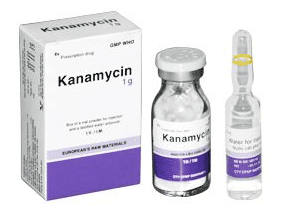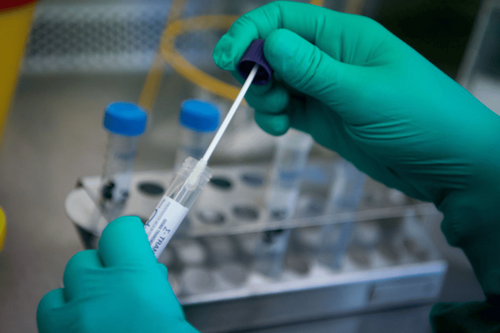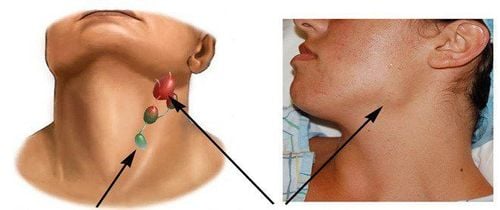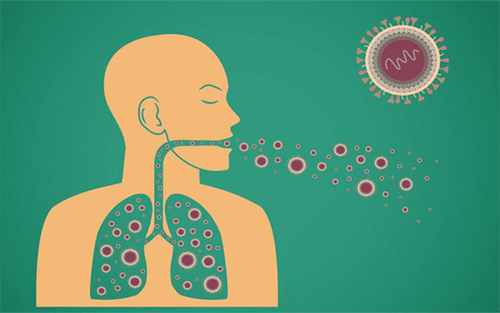This is an automatically translated article.
The article is professionally consulted by Master, Doctor Vu Van Quan - Gastroenterologist - Department of General Surgery & Anesthesiology - Vinmec Hai Phong International HospitalTuberculosis of the peritoneum can affect the reproductive health of women or even lead to death. Therefore, patients need to see a doctor as soon as they have symptoms of the disease to get a definitive diagnosis and have a timely and effective treatment plan.
1. Diagnosis of peritoneal tuberculosis
1.1 Clinical diagnosis Based on the symptoms and clinical examination for peritoneal tuberculosis, the doctor can diagnose whether the patient has TB disease or not. Specifically:
Tuberculosis of the peritoneum with free ascites:
Mild fever, about 37 - 38 degrees Celsius, often fever in the afternoon and at night, poor diet, weight loss and fatigue; Persistent dull abdominal pain or intermittent pain, pain location is not clear, abdominal distention, digestive disorders; Free ascites syndrome: Abdomen transverse, navel convex in lying position; abdominal skin tight, smooth; no collateral circulation; liver and spleen not enlarged; perforated low areas, opaque areas change according to the patient's position; liver and spleen not enlarged; When ascites is present, a comprehensive clinical examination is necessary to detect tuberculosis lesions in other organs: Pleural effusion (pleural effusion on the side of the effusion with syndrome 3 reduced, thoracic arch, dilated intercostal space). ); pericardial effusion (opaque area of the heart wider than normal, faint heart sound, possible right heart failure syndrome with hepatomegaly, distended jugular veins). Peptic ulcer peritoneal tuberculosis:
As the next stage of free ascites, the symptoms are more intense than the previous stage. Specifically:
Fever continuously lasts, there are fevers 39 - 40 degrees 9C; Weak state, fatigue, fast, small pulse and low blood pressure; Clustering abdominal pain, sometimes severe abdominal pain; Nausea and vomiting, persistent gastrointestinal disturbances (diarrhea alternating with episodes of constipation); Bloody stools; Women may have menstrual disorders: Dysmenorrhea, menorrhagia or amenorrhea; Abdomen distended, oval, large axis of abdomen along body, abdomen distended but asymmetrical; no collateral circulation; On examination of the abdomen, hard areas alternate with soft areas; pressure on the hard area has a yawning sound caused by the movement of the air in the loops; can palpate the iliac fossa hard mass (peritoneal mass), when pressing the hand on the abdominal wall and then suddenly removing the hand, the patient will feel increased pain; when typing, you will see the opaque area alternating with the clear area; A fistula of pus or stool may be seen outside the abdominal wall. Sticky sclerosing peritoneal TB:
The next stage of ascites or pox ulceration. There are the following clinical symptoms:
The whole body has the syndrome of infection, chronic intoxication, symptoms of fatigue, fever, etc. Localized abdominal pain, constipation, mechanical complications in the digestive organs such as volvulus, semi-obstruction or complete intestinal obstruction; The abdomen is not distended but shrinks due to progressive fibrosis, making the abdomen smaller than normal, the abdomen is concave due to the sticky fibers pulling the abdominal wall muscles; On physical examination, the abdomen is hard, concave, with hard bands or horizontal bands like ropes due to the adhesion of the large omentum (peritoneal cord sign), difficult to identify the abdominal organs.

1.2 Subclinical diagnosis Imaging techniques: Ultrasound of peritoneal tuberculosis (detection of peritoneal fluid and mesenteric lymph nodes), abdominal scan, computed tomography (CT TB peritoneal) pressure only used for special cases that are difficult to distinguish from other diseases; Test of peritoneal fluid: The peritoneal fluid is lemon yellow (maybe the first time the fluid is cloudy pink, the next time it changes to lemon yellow); Protein over 30g/l, positive Rivalta test; increased lymphocytes; direct endoscopic or homogenous staining of peritoneal fluid, AFB-positive rate is 5%, AFB-positive rate is 20-40% in culture; can apply new testing techniques such as ELISA, PCR,... for difficult-to-diagnose cases; Laparoscopy, peritoneal biopsy: Detects congested peritoneum, with tubercular granules, white or opaque yellow tuberculoma, scattered or clustered on 2 peritoneal leaves, with peritoneal adhesions ; on the biopsy specimen, the specific lesion is a tuberculous cyst; Mantoux reaction: Usually strongly positive; Blood tests: Elevated erythrocyte sedimentation rate, white blood cell count normal or slightly increased, lymphocyte count increased; Testing for TB lesions elsewhere: Patients with symptoms of cough and sputum expectoration suspected of pulmonary tuberculosis will have sputum testing and chest X-ray taken. Note for differential diagnosis:
Acute peritoneal tuberculosis: Differential diagnosis with acute peritonitis, intestinal volvulus, intestinal obstruction, appendicitis; Chronic peritoneal tuberculosis: Tuberculosis of the peritoneum with free ascites needs to be distinguished from cirrhosis of the liver, ascites, ascites in cancers (liver, stomach, colon, ovary,...) Demons Meigs syndrome, Pericarditis causes right heart failure. Peptic ulcerative peritoneal tuberculosis should be differentiated from lymph node involvement in lymphosarcomas, primary cancer, or intra-abdominal metastases. Adhesive sclerosing peritoneal TB is rare and not difficult to diagnose.
2. How to treat peritoneal TB
2.1 Principles of treatment Combination of anti-tuberculosis drugs: Each anti-tuberculosis drug has different effects on bacteria, so it is necessary to use it in combination. For drug-sensitive TB bacteria, the combination of at least 3 anti-TB drugs in the attack phase and at least 2 drugs in the maintenance phase. For MDR TB, a combination of at least 5 effective drugs, including pyrazinamide and 4 effective second-line TB drugs, is required; Use the right dose: Each anti-TB drug has a certain concentration, if used at low doses, it will be ineffective and easy to create drug-resistant strains of bacteria, if used in high doses, it can cause complications, so patients need to use drugs. the correct dose as prescribed by the doctor; Regular use of drugs: Anti-TB drugs must be taken at the same time at a certain time of day and far from meals to achieve maximum drug absorption; Use the drug for enough time in 2 phases of attack and maintenance: The attack phase lasts for 2-3 months to quickly destroy a large amount of bacteria in the affected areas to prevent drug-resistant mutant TB bacteria. The maintenance phase lasts 4-6 months to completely destroy the TB bacteria in the affected area and avoid recurrence.
Free ascites:
Using TB drugs: In mild and moderate cases, the formula 2RHZS/6HE can be applied; In severe cases, multi-chemotherapy can be used: 2RHZSE/1RHZE/5R3H3E3; Supportive treatment, ascites drainage about 1000ml each time and corticosteroid therapy combined with anti-tuberculosis drugs; Duration: taking the drug from 8 to 12 weeks, the dose in the first 1-2 weeks is 0.5 - 0.8 mg/kg body weight, gradually reducing the dose after each week as directed by the doctor; Symptomatic treatment: Anti-vomiting, diarrhea, constipation. Canker sores, fibrous adhesions:
Use of anti-tuberculosis drugs: In mild and moderate cases, the formula 2RHZS/6HE can be applied; In severe cases, multi-chemotherapy can be used: 2RHZSE/1RHZE/5R3H3E3; Supportive treatment, ascites drainage about 1000ml each time, do not use corticosteroids because of the risk of intestinal perforation, intestinal fistula and abdominal wall fistula; The duration of use of anti-tuberculosis drugs may be longer than that of free ascites; Rest and convalescence; When there is a complication of intestinal obstruction, cold abscess must be combined with surgical treatment. Combined peritoneal TB:
For patients with peritoneal TB combined with pulmonary TB, systemic TB, meningococcal TB, etc., the duration of attack and maintenance treatment is longer, it is necessary to combine 4-5 anti-tuberculosis drugs, high-dose and longer-lasting corticosteroids as prescribed by your doctor.
When diagnosed with peritoneal tuberculosis, patients need to strictly follow the doctor's instructions in treating the disease to recover from the disease early and avoid unpredictable complications.
Please dial HOTLINE for more information or register for an appointment HERE. Download MyVinmec app to make appointments faster and to manage your bookings easily.














